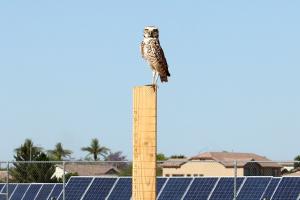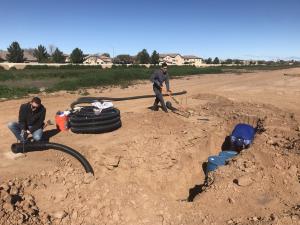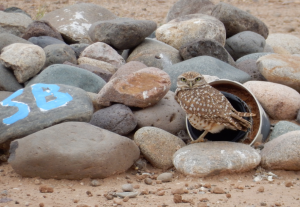Editor’s note: This is the first in a series of sustainability stories we’ll bring you over the summer. From our burrowing owl habitat and recycling efforts to our solar panels and garden, EMCC prides itself on its many sustainability practices. As Physics Professor Dr. Dwain Desbien said at the 23rd Annual Commencement Ceremony, “The best goal you can have in life is to leave the world a little better place for you having been in it.”
There’s no place like home for EMCC’s burrowing owls. Somewhere between 10 and 20 of the tiny birds (they’re only 8 to 10 inches tall when fully grown) currently live in man-made burrows on Estrella Mountain Community College’s campus.
The burrow-building project began around 2014 when two owls were discovered on the land where the Performing Arts Center (PAC) was slated to be constructed. EMCC officials contacted Wild at Heart, a rescue, rehabilitation, and release center for birds of prey, and were given two options: passive relocation, which involves building a burrow and hoping the owls will move to their new home, or capturing the owls and releasing them elsewhere. Passive relocation is the preferred method, so EMCC faculty and students teamed up with Wild at Heart experts, rolled up their sleeves, and got to work. But they didn’t just build one burrow, they built dozens, 48 to be exact.
“Our owls moved into their new home and we also took some from Wild at Heart, which were captured because they were being displaced by development,” said Dr. Rachel Smith, EMCC biology professor whose students helped build the burrows.
The name burrowing owl is perhaps a misnomer considering many don’t actually build their own burrows, especially in the western U.S. where the ground is too hard. Instead, they take up residence in vacated burrows built by other animals, such as prairie dogs. But because prairie dogs pose problems for farmers, they’ve been nearly eradicated, which has led to a decline in the burrowing owl population. Development hasn’t helped their numbers, either. Housing and commercial projects have led to burrows being plowed over and farm fields — a favorite hunting spot for burrowing owls — disappearing.
“We’re reducing their ability to get food and reducing the square footage of where they can live,” Smith said.
The owls aren’t yet considered to be endangered or threatened, making this an optimal time for humans to jump in and lend a helping hand.
“They’re not of concern right now, but that’s why they’re a good species to work on conserving because if you wait till they’re already in concern, then it’s either too late or you’re already in crisis mode,” Smith said. “We see the writing on the wall and their numbers are declining really quickly so it’s good to intervene while they’re still a viable wild population and it’s not so expensive. When their numbers get really low, it becomes really expensive to help them, but it’s pretty cheap to build the burrows.”
Fast forward to 2019 as EMCC inches closer to breaking ground on another new building and accompanying parking lot that just happens to be planned for the area of land that houses around half of the burrows built five years ago and passive relocation 2.0 gets underway.
“We had to rush to get the new burrows built by the end of February,” Smith said, explaining that the females migrate to Mexico for the winter and return in March when they lay their eggs.
With guidance from Wild at Heart, Smith and her students built dozens of new burrows surrounding the solar panels on the west side of campus, and just like in 2014, it worked.
“They just find the new burrow,” Smith said. “It’s amazing. They just seem to know. You build a burrow and like two hours later, there’s an owl sitting by it.”
Most of the students involved in the burrow-building projects have been biology students who have benefitted greatly from the experience.
“It was a really nice project because the students got to build something in a day, got to see it finished, and got to see the owls moving in,” Smith said. “It’s very rare that you get to do a conservation job that you actually see a great deal of progress. They really enjoyed it and they saw the point of doing it because the owls were watching us build the burrows.”
But the benefits of having burrowing owls on campus don’t stop there. The creatures Smith refers to as “strange” because “they didn’t read the handbook on how to be an owl” (they’re the only owl species that live in burrows and are diurnal as opposed to nocturnal) also provide a multitude of research opportunities. Dr. Jarod Raithel’s Life Sciences students just wrapped up a research project studying preferred perch heights at the request of Wild at Heart. They constructed dozens of perches set at varying elevations and studied the owls over a one-year period.
“My students ran a research project for a full year collecting transect data,” Raithel said. “I think we ended up analyzing 86 transects where students started at one point and over the course of 30 minutes walked to an endpoint recording what perches the owls were on.”
Interestingly enough, while burrowing owls don’t choose to light, or sit, in trees, instead preferring to stay closer to the ground, EMCC’s owls all chose the same perch height: the apex.
“They didn’t even use the perches,” Raithel said. “They all sat on the very top of the perch support pole. So our recommendation to Wild at Heart was, ‘If you’ve got owls in the area, there’s probably not a point in building perches; however if you have put in artificial burrows and are having trouble getting owls to occupy them, then taller is better.’”
The perch height study also put a feather in Jennifer Lance’s cap. The Life Sciences student won third place in the oral presentation category at this year’s Maricopa Student Research Conference for her project titled “Identifying Optimal Perch Heights Selected by Burrowing Owls at Artificial Burrows Across an Anthropogenic Landscape Gradient.” Kaylee Delcid, who was also in Raithel’s Life Sciences class, also won an award for her research on the owls. She won second place in the poster board category for her project “Measuring the Timing and Occupancy Patterns of Artificial Burrows Constructed for Burrowing Owls in the West Valley.”[a]
The most current research project involves placing underground cameras inside the burrows to monitor the owls.
“There have been above-ground webcams set up previously for other animals such as eagles and falcons, but there exists little to no webcams to view animals beneath the surface,” said Justin Van, who was in the Engineering Problem Solving and Design: ECE 103 (with EPICS projects) spring class that was tasked with devising the recording devices. “Our community partners, Wild at Heart, and the faculty members here at Estrella Mountain Community College hope to learn about the owls’ behaviors inside the burrows. They also would like to gather data about the number of burrowing owls’ offspring.”
The engineering students had to determine the project’s requirements, design the camera system to fulfill those requirements, and build the system as they designed it. They also had to test the system to ensure that it fulfilled the design requirements established at the start of the project.
“We all were able to get a real glimpse of what it truly means to be an engineer,” Van said. “The various steps we took to design our prototype lined up exactly with the engineering design process.”
Two prototypes have been created and the project is on track to resume in the fall. But for now, we’ll all just have to wait until June to see how many babies emerge from the burrows, and students and faculty will have to wait just a bit longer to find out what those funny little birds really do in their burrows.


